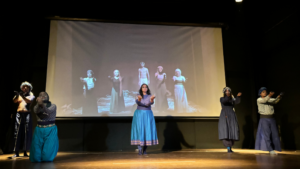An intersection of dance, theatre, and poetry with Omkar Bhatkar

They say some artists are born with a natural talent, while others argue that artistry can be developed through teaching and practice. Omkar Bhatkar falls into the former category. He is neither a trained dancer nor a trained theatre artist, but he is such a natural performer that dance, drama, and poetry flow effortlessly when he takes the stage. He claims to have learned through consuming all forms of art. This interview provides insight into Omkar Bhatkar’s creative process, the conceptual depth of his new show The Blue Flower and the challenges and successes of his multidisciplinary approach to performance art. Excerpts from the interview:
Tell me about your dance training and background.
My journey into the world of dance is quite unconventional. I didn’t undergo formal dance training; rather, my background is rooted in theatre and film. About 11 years ago, I ventured into writing and directing plays, establishing Metamorphosis Theatre Inc. My initial works were heavily verbal and existential, shaped by my self-taught understanding of literature, cinema, and visual arts. Over the years, I experimented with various forms, including experimental films, movement-based stage pieces, and poetry theatre. I began integrating movement and poetry into my work, developing a unique style that blends elements of dance and theatre. Although I don’t label myself strictly as a dancer or actor, I draw from both disciplines to create multidisciplinary performances. My role as a sociologist and educator provides a stable foundation, allowing me to pursue my passion for teaching while continuing to explore and innovate in performance art.
What is the concept behind The Blue Flower show?
The Blue Flower is a multidisciplinary performance that draws inspiration from various literary sources, particularly the German book Tale of the Blue Flower by Heinrich von Ofterdingen. The piece explores the search for an elusive blue flower, symbolizing lost moments of life that cannot be reclaimed. The narrative follows characters traveling through time and geography in their quest for a lost home, love, and childhood. The blue flower serves as an analogy for those fleeting, beautiful moments that shape our lives but are forever out of reach. We draw from the works of poets and thinkers like Mahmoud Darwish, Maria Popova, Margaret Mead, and Isabelle Eberhardt. The show blends literature, world music, physical theatre, and an abstract film to explore themes of distance, longing, and the quest for something unattainable.
How did the concept for The Blue Flower come about?
The concept for The Blue Flower emerged from a fascination with the interplay between distance and desire. Simone Weil wrote in a letter to a friend: “Let us love this distance, which is thoroughly woven with friendship since those who do not love each other are not separated.” So much of “the aggregate of our joy and suffering” that takes place on the planet seems to stem from this eternal tug-of-war between distance and desire. Weil’s 0idea that love exists in the space between people who are separated resonated deeply with me. This piece is a tribute to that concept, combining elements of literature, music, costumes, and physical theatre-dance. It addresses themes of loss and yearning through diverse characters: An Arabic woman’s loss of community, a Slovenian peasant woman’s loss of childhood, and a troubadour’s quest for the divine. We wanted to merge poetry, contemporary dance, Mohiniattam, Sufi whirling, and Noh Theatre to convey these themes in a rich, multidisciplinary format.
Can you give credit to the cast and crew involved in the show?
The performance features a talented cast including Ashmita Sunil, Vikram Pandey, Radhika Mhatre, Rekha Shetty, and myself. The music is composed by John and Nikhil Verghese, while Anosh Aibara has been responsible for sound mixing and video editing. I’ve handled the choreography, costume design, and overall aesthetics. Each member of the team has played a crucial role in bringing this complex, layered piece to life.
What has been the most challenging aspects of preparing for the show?
Preparing for a show like The Blue Flower involves numerous challenges, particularly in the pre-production phase. We need to record voice-over poems, create and mix music tracks, and ensure they align with the evolving flow of the play. Additionally, a background film must be shot and edited to synchronize with the final music and performance. This means that both the film and music are developed in tandem with the rehearsal process, requiring constant adjustments. Balancing literature research with the integration of poetry, music, and film is time-consuming but essential for achieving the desired artistic outcome.
What are your future plans for the show, and what’s next for you?
We plan to bring The Blue Flower to audiences again by October. Before that, we have a few exciting projects lined up. We will present Mapping of Mumbai, a poetic theatre adaptation of a new poetry collection about the city. Additionally, we have The Ecstatic Voices, a performance featuring devotional poetry from figures like Janabai and Shah Abdul Latif, combined with physical theatre and Sufi whirling. These projects reflect our ongoing exploration of blending different art forms and continuing to innovate in performance art.
How has the audience responded to The Blue Flower?
The response has been incredibly positive. At the Manifest Dance-Film Festival, audiences were visibly moved and engaged, describing the experience as otherworldly. The feedback we received one-on-one was particularly encouraging, with many expressing how the piece transported them to a different realm. It’s gratifying to see that our exploration of these deep, universal themes resonates with people and leaves a lasting impact.






